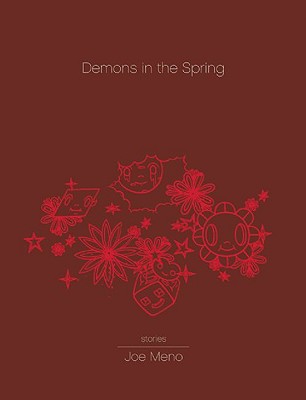
by by Margaret Kolb

Published by Akashic Books, 2008 | 280 pages
Joe Meno’s brain is a big dark attic full of chests built in sad cities and salvaged from the bellies of vessels from the past and future, from this planet and others. His work is known for its conflation of the absurd with the everyday but also for its simple, authentic dialogue and its intense empathy for its characters. His seventh book and second collection of short fiction, Demons in the Spring, finds him further cultivating these stylistic gardens.
Composed of twenty short stories with illustrations by twenty artists from the fine art, graphic art, and comic book worlds, Demons should not be missed. Emptiness and isolation haunt the characters that roam these stories. Loss and the sense of being lost are the coordinating themes that hang thick over them. An absurdity, too, burrows deep in the heart of Demons. Characters act an inch beyond human, a chemical apart from stable, a degree above normal. You ache with them and for them, but you are not sad. You smile with them and at them, but you are not happy. They seem supernatural but have no powers. There is magic in the type of melancholy that Meno dishes out.
In “The Boy Who Was a Chirping Oriole,” a child’s love for fireworks results in his disappearance. He literally vanishes before our eyes. The boy’s father narrates the story, describing his son’s favorite individual fireworks, those that contributed to his dematerialization. He lists the different fireworks out consecutively, throwing a sentence or two about his boy in, here and there. Ridiculous, certainly. Still, each mention of the boy brings with it progressively stronger and stronger quivers of the chin.
In “The Architecture of the Moon,” Meno shuffles, transposes, and leaves the laws of Newton, Einstein, and Hawking out in the rain. The moon has vanished and each onset of night causes the city to dismember. Buildings stretch their legs and whole city blocks and parks re-root, taking the people who occupy them along. In the midst of this, Meno’s focus is on the relationship between a man and his grown son. Every evening the man gets off work and calls his son to help him find his bearings, to locate that which is his own in the metamorphosing world around him. It is touching; it is tender; and it is out there.
In “It is Romance,” a teacher falls in love with the students in his Model United Nations club—all of them. He is not a pervert. He is not a predator. And yet, he is at odds with himself. He is uncomfortable with dating and uninspired by the sad, desperate men who seem to be the only ones available to him. The illogical, youthful exchanges between his Model UN students are what give him joy. His heart sings when the South Korean ambassador warns the Chinese ambassador that the U.S. has “like a hundred thousand” military bases in South Korea and that they invented taekwondo to attack Chinese soldiers on horse back—those being the reasons that China is not invincible. In what may be the most down-to-earth story of the collection, Meno shows that he does not need the surreal to showcase the frailty of his characters. They stand up and crumble just fine on their own.
In this collection nothing is ever resolved. No one knows what to do. No one can explain anything. No one can make anything better. And, yet, somehow that’s okay. Meno’s sentences, like Vonnegut’s, are simple, poignant, and playful. So are his ideas. Through them, the beauty of the characters balances the sense of emptiness that pervades their world. Meno is no nihilist. The worlds he creates, though damaged, are not broken. There is always beauty amid the emptiness, and it is precisely this diversity of mood and tone that makes the work succeed.
The final lines of the last story in the book, “Children Are the Only Ones Who Blush,” encapsulate the mood and feeling of the collection quite well. The book leaves off with a boy and girl just after they have taken a sick stray kitten to the vet to be euthanized:
Jill Thirby was still crying, and then we were waiting at the bus stop, and then we were getting on the bus, and the whole time we were sitting there she was still holding the empty cardboard box, and we sat beside each other, watching the buildings go by in a blur, riding past my stop, past the stop for her school, past the part of the city we knew, at that moment wondering who we were, what was going to happen to us, waiting, like everybody else, for someone to tell us what to do.Reading Demons in the Spring makes you feel like you are sitting there beside them.
Like its original hardcover release in 2008 from Akashic Books, the 2010 paperback edition of Demons in the Spring will see a portion of the proceeds donated to 826 Chicago, a nonprofit tutoring center.
SD Allison was born in Nebraska. He is the descendant of farmers, teachers, and men with bad lungs. He is the father of a little boy with autism. His first novel, Beneath the Plastic, was published in 2006. He is currently a senior copy writer for a marketing/ad agency.















click to see who
MAKE Magazine Publisher MAKE Literary Productions Managing Editor Chamandeep Bains Assistant Managing Editor and Web Editor Kenneth Guay Fiction Editor Kamilah Foreman Nonfiction Editor Jessica Anne Poetry Editor Joel Craig Intercambio Poetry Editor Daniel Borzutzky Intercambio Prose Editor Brenda Lozano Latin American Art Portfolio Editor Alejandro Almanza Pereda Reviews Editor Mark Molloy Portfolio Art Editor Sarah Kramer Creative Director Joshua Hauth, Hauthwares Webmaster Johnathan Crawford Proofreader/Copy Editor Sarah Kramer Associate Fiction Editors LC Fiore, Jim Kourlas, Kerstin Schaars Contributing Editors Kyle Beachy, Steffi Drewes, Katie Geha, Kathleen Rooney Social Media Coordinator Jennifer De Poorter
MAKE Literary Productions, NFP Co-directors, Sarah Dodson and Joel Craig